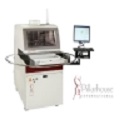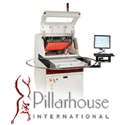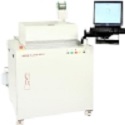|
Featured Article
|
BGA REWORK
Earl Moon
Proof Of Design (POD)
PRE OPERATIONAL REQUIREMENTS
The following requirements shall be met before beginning repair/rework operations:
Handling, ESD, and Moisture Sensitive Requirements
Ensure proper handling and ESD protection. In all cases it is required that ESD protection be provided all assemblies and all boards be handled so no damage, contamination, or other defect causing possibilities exist. Moisture sensitive requirements also are met in accordance with the company's specifications and procedures.
Thermal Profiling
Before any rework operations may be undertaken, processes must be thermally profiled. This pre-operational process is based on the same type factors involved in wave or reflow operations. These factors are component type, component location, board type (thermal mass) and, as applicable, solder paste or flux type used.
Figure 1 shows where an engineer set up a board with thermocouples on its surface (as close to a BGA's corner balls as possible) to derive temperatures and times used in the part removal process (this machine, and those similar, has a "learn" mode). Figure 2 shows a test board with thermocouples (pardon the use of 30 gauge fiber glass insulated wire as no 36 gauge was available) permanently implanted in through holes drilled in it. They were placed within very close proximity to each of a BGA's corners (a luxury seldom afforded with very difficult boards as the 16 layer in this case). Either way, the remove part sequence profile is used as a basis for subsequent reflow profiles.
|

Figure 1
|
|

Figure 2
|
|

Figure 3
|
|

Figure 4
|
Figure 3 shows a typical part removal profile at its peak and end (note the four thermocouple tracks within about 5 degrees C. indicating even heating at all part corners). Also note the peak top and bottom side heater temperatures, as red and blue lines, and their relationship to part profiles, or thermocouple readings. The remove profile is used, while in the "learn" mode, to derive a profile for later part place and reflow profiles. It is advisable to start low and move high with respect to temperatures as the lowest successful remove profile is sought.
Figure 4 shows a "site" where a part has been removed. On this rather difficult board, the site varies from one corner to another with respect to thermal mass and the temperatures required to remove the part. Note one corner being "cool", with little excess solder, while another is "hot" with excess solder "balling" or build up due to combining too much part/ball solder with that already present as solder paste and pad. As experience is gained over time, this type information plays an important role in formulating reflow profiles that are not too hot to cause bridging, nor too cold not to effect solder joint formation.
|
|
|
|
|
Sponsors
|




|
|
About This Newsletter
|
|
The SMT Express is a periodical featuring assembly solutions from your peers and vendors. We, at SMTnet.com, have designed this newsletter to bring useful information to the mailboxes of electronics manufacturing professionals.
Since we are just getting started, we need your help to make this a relevant and welcome publication. We want your feedback, suggestions, complaints, and compliments. We also want your articles. Please read the submission guidelines and Contact Us regarding article and news submissions.
- Thanks in advance
To Subscribe:
Click here to register with SMTnet.com to receive this newsletter and many other benefits. It's absolutley free!
To Unsubscribe:
Click here to send an unsubscribe email message. Be sure to include your email address in the body and include the word "unsubscribe" in the subject line.
Newsletter Archives:
Click here to to visit the SMT Express home page. A list of archives can be found there in the menu on the left.
Board of Editors:
Click here to learn more about the SMT Express Board of Editors.
|
|